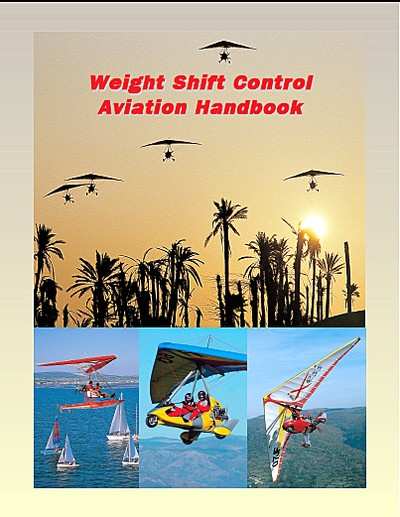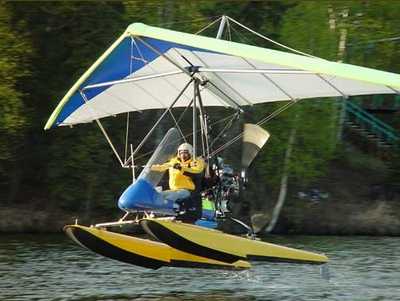Publication Aimed Specifically At Sport Pilots
By ANN Contributor Jon Thornburgh
A new trike handbook received wide acclaim at the April 2005 Sun
'n Fun Fly-In at Lakeland, Florida. The book was available at the
Air Creation display in the ultralight area.
The Weight Shift Control Aviation Handbook is specifically
designed to accommodate the new Sport Pilot initiative, although
it's also instructive for ultralight pilots. It was written by
Kemmeries Aviation instructor Eric Johnson, with "technical
support" from John Kemmeries, maintenance expert Greg Silva, flight
instructor Richard Michaels, and Editor Julie Potter.

The Handbook is printed on 8 1/2 by 11 inch paper, and bound by
a spiral ring. The 160 page manual contains 11 chapters, entitled
"Introduction to Weight Shift Control and Sport Pilot
Certification," "Components and Systems," "Preflight Procedures,"
"Flight Controls and Maneuvers," "Emergency Procedures, "Airport
Operations," "Aerodynamics," "Aircraft and Pilot Performance,"
"Weather," "Navigation," and "Aero-medical Factors.
The book has beautiful color illustrations, including drawings,
schematics, and photographs. Even the vibrant cover page depicts a
dramatic sunset and several trikes in flight.
Although the subjects discussed contain all the information
required to pass the Sport Pilot knowledge test, much of the book
presents the practical "real life" information a trike pilot needs
to know about weight shift aircraft. There is an excellent
discussion of the components of a trike wing, accompanied by
photographs with the various parts of the wing pointed out by
arrows and captions. Chapter 2 details airframe components,
engines, fuel, electrical, and cooling systems, and items unique to
trike wings such as "sprogs," "washout struts," and "billow."
The requirements and steps to become a weight shift Sport Pilot
are in the first chapter, as well as the procedures for getting a
weight shift Private Pilot certificate and Sport Pilot Instructor's
license. Aircraft certification and information about experimental
trikes are also discussed.

Chapter 3 presents the method of setting up and removing the
trike wing, transporting a trike, and examining the aircraft before
flight. The illustrations accompanying the article are excellent,
and the captions detail the exact items to preflight. Especially
helpful are the lists of "Common Errors" associated with wing
assembly.
In addition to the subjects unique to weight shift trikes there
are many items presented in the book, which are generic to flying
all aircraft. Much of the generic material is almost copied
verbatim from FAA publications, such as the FAA's Pilot's Handbook
of Aeronautical Knowledge, which is public domain material, and not
copyrighted.
The generic material includes the new FAA emphasis on
"Aeronautical Decision Making" (ADM.) Thanks to improved
maintenance, advanced weather forecasting, better navigation aids
such as GPS, and wider use of transponders and radios, the general
aviation accident rate has continued to decrease. But "pilot error"
is still a significant factor in accidents, so there is a concerted
effort to expose pilots to the tools for better evaluating certain
risks, and making wiser decisions related to safety. The ADM
presentation in Chapter 4 of the Weight Shift Control Aviation
Handbook is very similar to the FAA's discussion of ADM in Chapter
16 of the Handbook of Aeronautical Knowledge.
 Similarly, the "Airport Markings and
Signs" diagram on page 6-2 of the weight shift Handbook is the same
as the diagram on page 12-4 of the FAA pilot Handbook. This is not
to malign the weight shift handbook, but rather to note that it
covers enough generic aviation material that the weight shift
handbook can almost be a stand-alone study guide.
Similarly, the "Airport Markings and
Signs" diagram on page 6-2 of the weight shift Handbook is the same
as the diagram on page 12-4 of the FAA pilot Handbook. This is not
to malign the weight shift handbook, but rather to note that it
covers enough generic aviation material that the weight shift
handbook can almost be a stand-alone study guide.
Other generic material includes weather, navigation and
aeromedical issues. The aerodynamic discussion in Chapter 7,
although partially generic, also contains information unique to
trikes, such as the dynamics of a weight shift wing in a turn.
It's obvious that a lot of thought and effort went into drafting
the Weight Shift Control Aviation Handbook, and it's certain to
become the industry-leading book on the subject. The only change I
would have made if I had written the book would have been to
separate the "Introduction to Weight Shift Control" and "Sport
Pilot Certification" subjects into two chapters, rather than
combine them together in Chapter One.
 Airbus Racer Helicopter Demonstrator First Flight Part of Clean Sky 2 Initiative
Airbus Racer Helicopter Demonstrator First Flight Part of Clean Sky 2 Initiative Diamond's Electric DA40 Finds Fans at Dübendorf
Diamond's Electric DA40 Finds Fans at Dübendorf ANN's Daily Aero-Term (04.23.24): Line Up And Wait (LUAW)
ANN's Daily Aero-Term (04.23.24): Line Up And Wait (LUAW) NTSB Final Report: Extra Flugzeugbau GMBH EA300/L
NTSB Final Report: Extra Flugzeugbau GMBH EA300/L Classic Aero-TV: 'Never Give Up' - Advice From Two of FedEx's Female Captains
Classic Aero-TV: 'Never Give Up' - Advice From Two of FedEx's Female Captains





